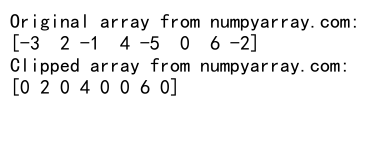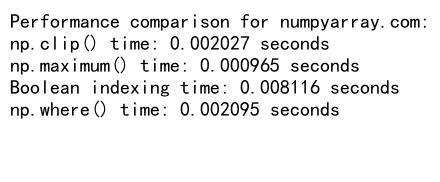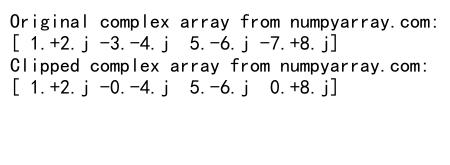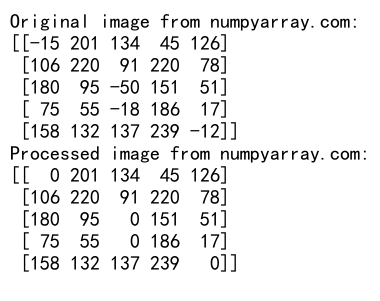NumPy Clip Negative Values to Zero
NumPy is a powerful library for numerical computing in Python, offering a wide range of functions and tools for working with arrays and matrices. One common operation in data processing and analysis is clipping negative values to zero, which can be achieved using NumPy’s capabilities. This article will explore various methods and techniques to clip negative values to zero in NumPy arrays, providing detailed explanations and examples along the way.
Introduction to NumPy and Clipping
NumPy (Numerical Python) is a fundamental package for scientific computing in Python. It provides support for large, multi-dimensional arrays and matrices, along with a collection of mathematical functions to operate on these arrays efficiently. Clipping, in the context of NumPy, refers to the process of limiting values in an array to a specified range. In this case, we’re focusing on clipping negative values to zero, which is a common operation in various fields such as image processing, signal processing, and data analysis.
Let’s start with a basic example of how to clip negative values to zero using NumPy:
import numpy as np
# Create a sample array with positive and negative values
arr = np.array([-3, 2, -1, 4, -5, 0, 6, -2])
# Clip negative values to zero
clipped_arr = np.clip(arr, 0, None)
print("Original array from numpyarray.com:")
print(arr)
print("Clipped array from numpyarray.com:")
print(clipped_arr)
Output:

In this example, we use the np.clip() function to clip all values below 0 to 0, while leaving positive values unchanged. The None argument for the upper bound means there’s no upper limit.
Understanding np.clip()
The np.clip() function is a versatile tool for limiting the values in an array. Its general syntax is:
np.clip(a, a_min, a_max, out=None)
a: The input arraya_min: Minimum value to clip toa_max: Maximum value to clip toout: Optional output array to store the result
When clipping negative values to zero, we set a_min=0 and a_max=None. Let’s look at a more detailed example:
import numpy as np
# Create a 2D array with positive and negative values
arr_2d = np.array([[-2, 3, -1, 4],
[5, -6, 0, -3],
[-4, 1, -5, 2]])
# Clip negative values to zero
clipped_2d = np.clip(arr_2d, 0, None)
print("Original 2D array from numpyarray.com:")
print(arr_2d)
print("Clipped 2D array from numpyarray.com:")
print(clipped_2d)
Output:

This example demonstrates how np.clip() works with multi-dimensional arrays, clipping all negative values to zero while preserving the array’s structure.
Alternative Methods for Clipping Negative Values
While np.clip() is the most straightforward method, there are other ways to achieve the same result. Let’s explore some alternatives:
Using np.maximum()
The np.maximum() function can be used to compare an array with a scalar value element-wise and return the maximum of the two:
import numpy as np
# Create a sample array
arr = np.array([-1, 2, -3, 4, -5, 6])
# Clip negative values to zero using np.maximum()
clipped_arr = np.maximum(arr, 0)
print("Original array from numpyarray.com:")
print(arr)
print("Clipped array using np.maximum() from numpyarray.com:")
print(clipped_arr)
Output:

This method is efficient and easy to understand, as it simply replaces each element with the maximum of itself and zero.
Using Boolean Indexing
We can use boolean indexing to selectively replace negative values with zero:
import numpy as np
# Create a sample array
arr = np.array([-2, 3, -1, 4, -5, 0, 6, -3])
# Create a copy of the array
clipped_arr = arr.copy()
# Replace negative values with zero using boolean indexing
clipped_arr[clipped_arr < 0] = 0
print("Original array from numpyarray.com:")
print(arr)
print("Clipped array using boolean indexing from numpyarray.com:")
print(clipped_arr)
Output:

This method creates a boolean mask for negative values and then assigns zero to those positions.
Using np.where()
The np.where() function allows us to replace values based on a condition:
import numpy as np
# Create a sample array
arr = np.array([-1, 2, -3, 4, -5, 6])
# Clip negative values to zero using np.where()
clipped_arr = np.where(arr < 0, 0, arr)
print("Original array from numpyarray.com:")
print(arr)
print("Clipped array using np.where() from numpyarray.com:")
print(clipped_arr)
Output:

This method replaces negative values with zero and keeps positive values unchanged.
Performance Considerations
When working with large arrays, performance becomes a crucial factor. Let’s compare the performance of different methods:
import numpy as np
import time
# Create a large array with random values
large_arr = np.random.randint(-100, 100, size=1000000)
# Method 1: np.clip()
start_time = time.time()
clipped_1 = np.clip(large_arr, 0, None)
clip_time = time.time() - start_time
# Method 2: np.maximum()
start_time = time.time()
clipped_2 = np.maximum(large_arr, 0)
max_time = time.time() - start_time
# Method 3: Boolean indexing
start_time = time.time()
clipped_3 = large_arr.copy()
clipped_3[clipped_3 < 0] = 0
bool_time = time.time() - start_time
# Method 4: np.where()
start_time = time.time()
clipped_4 = np.where(large_arr < 0, 0, large_arr)
where_time = time.time() - start_time
print("Performance comparison for numpyarray.com:")
print(f"np.clip() time: {clip_time:.6f} seconds")
print(f"np.maximum() time: {max_time:.6f} seconds")
print(f"Boolean indexing time: {bool_time:.6f} seconds")
print(f"np.where() time: {where_time:.6f} seconds")
Output:

This example compares the execution time of different methods for clipping negative values to zero on a large array. The results may vary depending on the system and array size, but generally, np.maximum() and np.clip() tend to be the fastest methods.
Handling Special Cases
When working with NumPy arrays, it’s important to consider special cases such as NaN (Not a Number) values, infinity, and complex numbers.
Dealing with NaN Values
NaN values require special attention when clipping:
import numpy as np
# Create an array with NaN values
arr_with_nan = np.array([-1, 2, np.nan, -3, 4, np.nan])
# Clip negative values to zero, preserving NaN
clipped_arr = np.where(np.isnan(arr_with_nan), np.nan, np.clip(arr_with_nan, 0, None))
print("Original array with NaN from numpyarray.com:")
print(arr_with_nan)
print("Clipped array preserving NaN from numpyarray.com:")
print(clipped_arr)
Output:

This example demonstrates how to clip negative values to zero while preserving NaN values in the array.
Handling Infinity
Infinity values also need special consideration:
import numpy as np
# Create an array with infinity values
arr_with_inf = np.array([-np.inf, 2, -1, np.inf, -3, 4])
# Clip negative values to zero, including negative infinity
clipped_arr = np.clip(arr_with_inf, 0, None)
print("Original array with infinity from numpyarray.com:")
print(arr_with_inf)
print("Clipped array handling infinity from numpyarray.com:")
print(clipped_arr)
Output:

This example shows how np.clip() handles infinity values, clipping negative infinity to zero while preserving positive infinity.
Working with Complex Numbers
Clipping complex numbers requires a different approach:
import numpy as np
# Create an array with complex numbers
complex_arr = np.array([1+2j, -3-4j, 5-6j, -7+8j])
# Clip the real part of negative values to zero
clipped_complex = np.where(complex_arr.real < 0, complex_arr.imag * 1j, complex_arr)
print("Original complex array from numpyarray.com:")
print(complex_arr)
print("Clipped complex array from numpyarray.com:")
print(clipped_complex)
Output:

This example demonstrates how to clip the real part of complex numbers to zero while preserving the imaginary part.
Applications of Clipping Negative Values
Clipping negative values to zero has various applications in different fields. Let’s explore some practical examples:
Image Processing
In image processing, clipping negative values is often used in operations like image enhancement:
import numpy as np
# Simulate a grayscale image with some negative values due to noise
image = np.random.randint(-50, 256, size=(5, 5))
# Clip negative values to zero
processed_image = np.clip(image, 0, 255)
print("Original image from numpyarray.com:")
print(image)
print("Processed image from numpyarray.com:")
print(processed_image)
Output:

This example simulates a noisy grayscale image and clips the pixel values to the valid range of 0-255.
Financial Data Analysis
In financial analysis, negative values might represent losses that need to be handled differently:
import numpy as np
# Simulate daily stock returns
returns = np.array([-0.02, 0.03, -0.01, 0.04, -0.03, 0.02])
# Clip negative returns to zero for a specific analysis
clipped_returns = np.clip(returns, 0, None)
print("Original returns from numpyarray.com:")
print(returns)
print("Clipped returns from numpyarray.com:")
print(clipped_returns)
Output:

This example demonstrates clipping negative stock returns to zero, which might be useful in certain types of financial analysis.
Advanced Techniques
Let’s explore some advanced techniques for clipping negative values to zero in NumPy arrays.
Using np.frompyfunc() for Custom Clipping
We can create a custom universal function using np.frompyfunc() for more complex clipping operations:
import numpy as np
# Define a custom clipping function
def custom_clip(x):
return max(0, x)
# Create a universal function
custom_clip_ufunc = np.frompyfunc(custom_clip, 1, 1)
# Create a sample array
arr = np.array([-2, 3, -1, 4, -5, 0, 6, -3])
# Apply the custom clipping function
clipped_arr = custom_clip_ufunc(arr).astype(float)
print("Original array from numpyarray.com:")
print(arr)
print("Clipped array using custom function from numpyarray.com:")
print(clipped_arr)
Output:

This example demonstrates how to create a custom clipping function and apply it to an array using np.frompyfunc().
Clipping with Tolerance
Sometimes, we might want to clip values that are very close to zero but slightly negative:
import numpy as np
# Create an array with small negative values
arr = np.array([-1e-10, 2, -1e-8, 3, -1e-6, 4])
# Clip values with a tolerance
tolerance = 1e-9
clipped_arr = np.where(arr < -tolerance, 0, arr)
print("Original array from numpyarray.com:")
print(arr)
print("Clipped array with tolerance from numpyarray.com:")
print(clipped_arr)
Output:

This example shows how to clip values to zero if they are below a certain negative threshold.
NumPy Clip Negative Values to Zero Conclusion
Clipping negative values to zero is a common operation in NumPy that has various applications in data processing, image analysis, and scientific computing. We’ve explored multiple methods to achieve this, including np.clip(), np.maximum(), boolean indexing, and np.where(). Each method has its strengths and may be more suitable depending on the specific use case and performance requirements.
We’ve also discussed handling special cases like NaN values, infinity, and complex numbers, as well as explored some advanced techniques and real-world applications. By understanding these concepts and methods, you can effectively manipulate NumPy arrays and handle negative values in your data processing tasks.
Remember to consider the specific requirements of your project when choosing a method for clipping negative values to zero. Factors such as array size, performance needs, and the presence of special values should all be taken into account. With the knowledge gained from this article, you should be well-equipped to handle a wide range of scenarios involving negative value clipping in NumPy arrays.